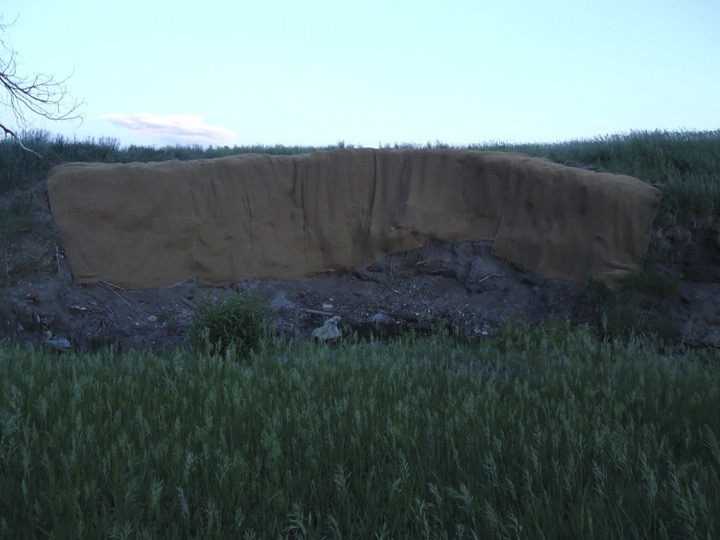
Arvada City Council Reverses Course on Controversial Landfill Development
4
290
1
Council Approves Comprehensive Plan Change Despite Strong Public Opposition and Environmental Concerns
The Arvada City Council voted 7-0 on Tuesday, October 21, 2025, to change the comprehensive plan designation for a former landfill at 6800 Kilmer Street from "mixed-use residential" to "industrial office"—reversing their 6-1 vote from November 2024 that had denied the same request. The property, operated as a county landfill from the 1930s-1970s, contains asbestos, arsenic, and generates methane gas.
The reversal appears driven by concerns about a potential "takings" lawsuit that City Attorney Rachel Morris estimated could cost the city over a million dollars in damages and legal fees. Despite strong public opposition citing environmental safety concerns, contamination risks to Ralston Creek, and lack of substantive project changes since the 2024 denial, council members reframed the issue as a technical zoning correction rather than a land use compatibility decision.
The comprehensive plan change allows any light industrial use on the property, not just the proposed RV/boat storage facility.
The Site's Troubled History
The 14-acre property was operated as a municipal landfill by Jefferson County from the 1930s through the 1970s. The site contains municipal waste, asbestos, arsenic above EPA residential screening levels, and generates methane gas as organic materials decompose. Photos below are from a site investigation after a flood in 2013.
Applicant Chelton LLC purchased the property for $85,000 in 2012 and has proposed developing it as an RV and boat storage facility with 355 parking spaces. The company's attorney, Scott Clark, argued that the conflict between the comprehensive plan and zoning designations leaves the property "undevelopable" and that residential development is impossible due to environmental contamination.
Public Raises Alarm Over Environmental Risks
Public comment revealed deep concerns about environmental safety, financial liability, and procedural fairness. Technical experts and residents questioned what substantive engineering improvements had addressed public safety, compatibility and creek contamination concerns since the project's rejection last year. Multiple speakers noted the project appears focused on minimal remediation rather than comprehensive cleanup, potentially shifting long-term liability from an out-of-state developer to the community.
Multiple residents cited concerning findings from geotechnical reports. Rainer Gerbatsch, a Geos neighborhood resident, pointed to warnings about "certain settlement, gas generation, contaminant migration and inherent unpredictable instability" along with documented presence of "arsenic above EPA residential and regional screening levels and asbestos at 6%."
The site borders Ralston Creek and the Croke Canal, raising additional concerns about creek bank stabilization. The city's floodplain manager had previously concluded that bank stabilization efforts would be unsuccessful due to the creek's constrained nature. After a 2013 flood, waste breached into Ralston Creek. Speakers raised concerns about ongoing creek bank erosion and what would protect the waterway during future floods, noting that city staff stated stabilization work is necessary to protect the facility and cannot become the city's responsibility.
Several speakers noted that the proposal lacks an active gas collection system or monitoring plan for methane releases. Questions were raised about who would respond when hazardous pore gases are expelled as settlement compresses the waste, with concerns that such emergencies would fall to the city.
Community Questions Procedural Fairness
Former Arvada Mayor Mark Williams submitted a letter read by resident Rick Simms, expressing disappointment that the matter returned to council. "Less than a year ago, both the Planning Commission and the City Council rejected on a 6 to 1 vote this project, in part for reasons consistent with this letter," Williams wrote. "I was frankly disappointed that the matter is now before you again. The integrity of the council decisions requires consistency."
Several speakers raised questions about the legal authority for the rehearing. James Silvestro, attorney representing Friends Of Ralston Creek—an association of neighbors concerned about the development—argued that state law gives only the Planning Commission authority to amend the comprehensive plan, and that the council's reconsideration of new evidence violated the Land Development Code's prohibition on considering new information in administrative appeals.
City Attorney Morris defended the council's authority, stating that Section 53 of the Comprehensive Plan and Section 8-121-E4 of the Land Development Code both provide for City Council consideration and adoption of comprehensive plan amendments. "Neither the city code nor comprehensive plan designates the Planning Commission as the final authority on such amendments," Morris explained.
The applicant's attorney acknowledged the takings issue looming over the proceedings. "Mr. Silvestro began his presentation talking about takings. And of course, you're not determining tonight whether there is a takings, and nobody is presenting that issue, but it is looming out there large," said the applicant's attorney during rebuttal, referring to James Silvestro's arguments on behalf of Friends Of Ralston Creek.
Limited Changes Since Last Denial
The applicant presented some modifications since November 2024, including adding a 7-foot opaque cedar fence, increasing landscaping by 25%, and raising berms along the southern border to approximately 6 feet.
However, residents argued these cosmetic changes failed to address fundamental compatibility and safety concerns.
A Reversal of Position
Notably, every council member except Marriott (and Rupert, who was not yet on council in November 2024) had previously voted to deny the comprehensive plan change, citing compatibility and public welfare concerns. During public comment, residents played recordings of council members' own statements from that denial.
Council Member Bob Fifer, who made the motion to deny in November 2024, had stated at that time: "The heavy lift being gone through a couple of the comprehensive plan criteria... to me, is that the plan? Keeping it, you know, the way it is... regardless of who's applying for what, because we can sit here all day long and spitball... I got to look at it in the lens of is it light industrial or is it mixed use residential?" He had concluded the proposal did not meet compatibility criteria required by the Comprehensive Plan.
Yet in October 2025, several of these same council members voted to approve. The shift appears related to concerns about the legal and financial risks of maintaining the zoning-comprehensive plan mismatch, rather than substantive changes to the project itself. When asked about the consequences of a potential takings lawsuit, City Attorney Rachel Morris indicated it could cost the city over a million dollars plus attorney fees and staff time, seemingly weighing heavily on the council's reconsideration.
David Soucie, a licensed property adjuster with over 30 years of experience, noted that neither the developer nor city had conducted a community fiscal impact study. "Without that analysis, we don't know how much homeowners' insurance premiums will rise or how far property values will fall. From my experience in 30 years as an insurance adjuster and underwriting, those impacts will be significant, negative, and measurable for every one of the thousands of nearby homeowners."
Shāna Boutté, United Nations ambassador of humanity and peace and a voice of the international disability community who works with the UN Sustainable Development Goals, raised concerns about impacts on medically fragile residents. "I built my home, a disability home in Geos for medically fragile people in 2015 due to the clean environment, meaning water, air and soil," she said. "The RV storage will threaten the disabled and medically fragile people in local neighborhoods. Think in terms of ADA rights and laws which are upheld by the city."
Boutté warned that approval of the project could result in Arvada losing its recognition as a sustainability leader with the United Nations, potentially removing the city from the UN's sustainable communities list.
Council's Rationale for Approval
Council Member John Marriott made the motion to approve, calling the situation "an unintentional anomaly" created by the mismatch between zoning and the comprehensive plan.
"I don't see any evidence that there was anything that was intended to change the zoning of this land with the adoption of the comp plan way back in 2005 or whenever it happened," Marriott said. He noted the property is bounded by Ralston Creek and Croke Canal on three sides, with the fourth side adjoining the city's own industrial property and other industrial uses.
This marked a significant shift from November 2024, when the council's focus had been on whether the proposal met compatibility criteria and public welfare standards outlined in the comprehensive plan. In 2025, the discussion centered instead on legal exposure, the impracticality of leaving the property in regulatory limbo, and the physical constraints posed by the surrounding industrial uses and waterways—effectively reframing the issue as a technical zoning correction rather than a land use compatibility decision.
However, community advocate Gina Hallisey challenged the notion that industrial zoning was the only compatible option. "Compatibility does not mean the same as," she told the council. "Rather, compatibility refers to the sensitivity of development proposals in maintaining the character of existing development. Industrial areas can coexist with residential or open space through transitional zones like mixed use residential."
City staff clarified that approval of the comprehensive plan amendment does not constitute approval of any specific development. The applicant must still go through the site development plan process, which includes detailed review by city staff, coordination with the Colorado Department of Public Health and Environment (CDPHE), and referrals to relevant agencies including Mile High Flood District.
Staff also confirmed that after the administrative site plan approval, City Council members would have a 17-day window to request the project be called up for council review, providing another opportunity for public input.
When asked whether it was impossible to develop mixed-use residential on the former landfill, staff indicated they rely on CDPHE's expert guidance. The applicant's Voluntary Cleanup Plan (VCUP) approved by CDPHE in 2023 was exclusively for commercial uses.
However, resident Mike Rawluk challenged the applicant's assertion that only RV storage could work on the site, providing several examples of uses that would comply with light industrial zoning.
Rawluk listed alternative light industrial uses including offices for general contractors, specialty subcontractors, tradesmen, and telecommunication providers—"including parking of commercial vehicles or a fleet of cars, vans or light trucks that are used in business. Sounds very similar to an RV storage park. All you got to do is put one small office and have Xfinity have their vehicles there instead."
He also raised concerns about other permissible light industrial uses that could be more problematic than RV storage: "Food production, beverage production, furniture making, manufacturing, textiles... screen printing, printing and publishing, research, development and testing laboratories." Rawluk specifically questioned whether a psilocybin facility—a newly legal use the city had recently discussed—could be established on the property. "You vote tonight, they put up more Quonset huts or greenhouses... and now all of a sudden, you got a psilocybin facility in very close proximity to homes."
Rawluk also challenged the timeline pressures suggested by the applicant, noting through a Colorado Open Records Act (CORA) request that he found "no additional documents responsive to this request" for VCUP timeline extensions or modifications. "Right now they have not requested an extension," he said. "If they don't start work by November 2025, they will have to reapply to the VCUP."
The Vote and What's Next
The council voted 7-0 to approve the comprehensive plan amendment, with Council Member Marriott making the motion.
Community advocates indicated they plan to remain engaged as the project moves through the development approval process.
"I applaud you all for trying, but I think you're going to see this again and you'll probably hear from us again. And I'll probably be wearing my green shirt because it's by the creek and we protect the creek at all costs," said Gina Hallisey.
Though the vote was an understandable housekeeping need to align zoning and comprehensive plan requirements for the property, residents remain concerned about City Council's understanding of environmental regulations and expectations for remediation, innovative solutions for the property not presented by the applicant, and the potential use of public waterways as a buffer between industrial and residential properties. With environmental remediation costs estimated in the tens of millions of dollars and significant technical challenges related to methane generation, ground settlement, and creek bank stabilization, the path forward for any development remains complex and heavily scrutinized by the community.
The October 21, 2025 meeting also included approval of the city's 2026 budget, water rate increases, and proclamations recognizing National Community Planning Month and Law Enforcement Records Personnel Week. Council members John Marriott and Brad Rupert are completing their final terms on the council, with the election scheduled for November 4, 2025.



























I livestreamed the presentation of both sides of this issue. It is complex and involved. So much so, it's hard to believe the City Council had not already considered the developer's side and made their decision prior to the meeting. It seems to me the meeting was not intended to hear all arguments, debate, decide and vote. Rather it was "eyewash" to give the Maple Valley and Geo neighborhood folks the impression their concerns were being heard and considered in the decision process. The meeting was "lip service" to the citizenry. It disrespected those in the affected neighborhoods. Every member of the City Council should be voted out.
As an aside, Karen made a great presentation from a professional environmental standpoint on behalf of the affected neighborhoods. Alas, it was to no avail.